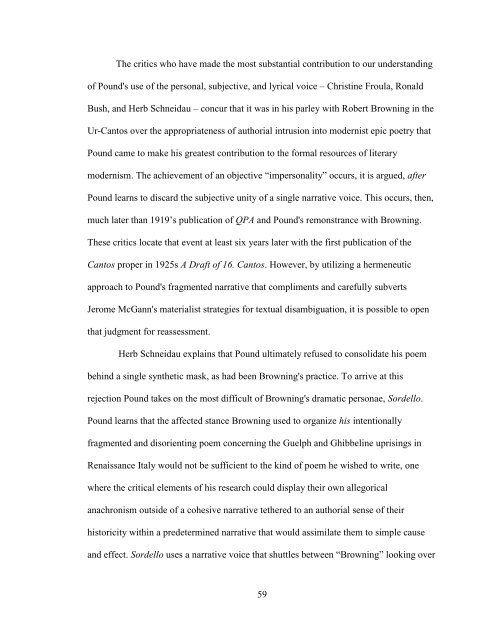TABOO: THE ACTUAL MODERNIST AESTHETIC, MADE REAL A ...
TABOO: THE ACTUAL MODERNIST AESTHETIC, MADE REAL A ...
TABOO: THE ACTUAL MODERNIST AESTHETIC, MADE REAL A ...
You also want an ePaper? Increase the reach of your titles
YUMPU automatically turns print PDFs into web optimized ePapers that Google loves.
The critics who have made the most substantial contribution to our understanding<br />
of Pound's use of the personal, subjective, and lyrical voice – Christine Froula, Ronald<br />
Bush, and Herb Schneidau – concur that it was in his parley with Robert Browning in the<br />
Ur-Cantos over the appropriateness of authorial intrusion into modernist epic poetry that<br />
Pound came to make his greatest contribution to the formal resources of literary<br />
modernism. The achievement of an objective ―impersonality‖ occurs, it is argued, after<br />
Pound learns to discard the subjective unity of a single narrative voice. This occurs, then,<br />
much later than 1919‘s publication of QPA and Pound's remonstrance with Browning.<br />
These critics locate that event at least six years later with the first publication of the<br />
Cantos proper in 1925s A Draft of 16. Cantos. However, by utilizing a hermeneutic<br />
approach to Pound's fragmented narrative that compliments and carefully subverts<br />
Jerome McGann's materialist strategies for textual disambiguation, it is possible to open<br />
that judgment for reassessment.<br />
Herb Schneidau explains that Pound ultimately refused to consolidate his poem<br />
behind a single synthetic mask, as had been Browning's practice. To arrive at this<br />
rejection Pound takes on the most difficult of Browning's dramatic personae, Sordello.<br />
Pound learns that the affected stance Browning used to organize his intentionally<br />
fragmented and disorienting poem concerning the Guelph and Ghibbeline uprisings in<br />
Renaissance Italy would not be sufficient to the kind of poem he wished to write, one<br />
where the critical elements of his research could display their own allegorical<br />
anachronism outside of a cohesive narrative tethered to an authorial sense of their<br />
historicity within a predetermined narrative that would assimilate them to simple cause<br />
and effect. Sordello uses a narrative voice that shuttles between ―Browning‖ looking over<br />
59
















